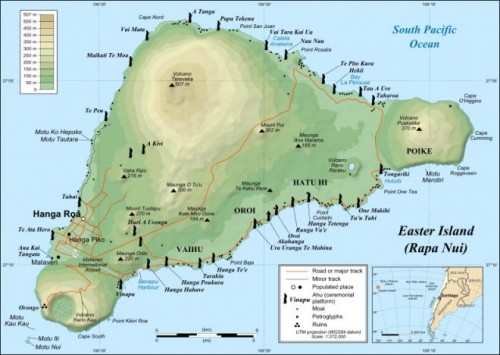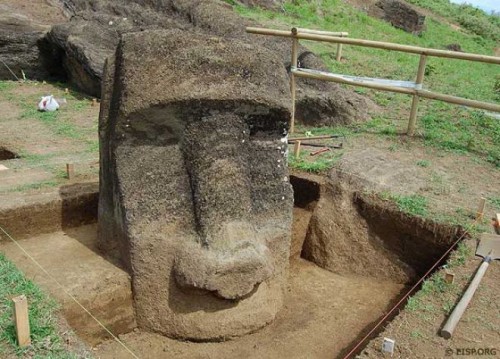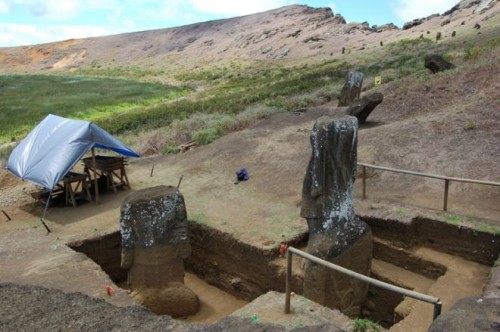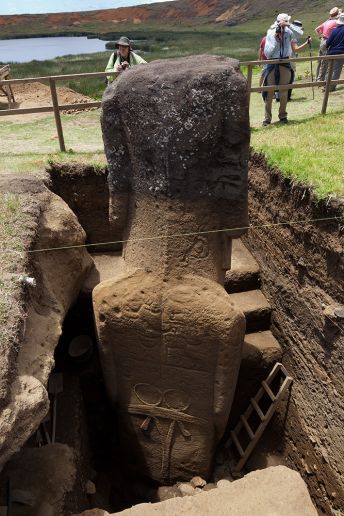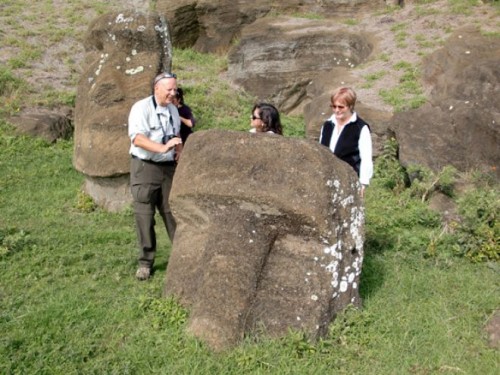 We’ve all had those smack your skull, why didn’t I think of that, duh moments, right?
We’ve all had those smack your skull, why didn’t I think of that, duh moments, right?
In all the years of seeing reports and stories about the carved heads that populate Easter Island, not once did I ever consider the idea that they were attached to stone bodies. However, it would seem that is exactly the case and it’s not just a few as every single one of the approx 1,000 sentinel statues are as complete as can be, from the top of their oddly shaped heads to the feet of their….errr, feet!
Apparently, Jo Anne Van Tilburg, director of the Easter Island Statue Project decided it was high time someone started digging to find out what lay below the surface.
Van Tilburg, who is also a fellow with The Cotsen Institute of Archaeology at the University of California has been fascinated with the strange figures which seem to stand guard over the Island for quite some time. In fact, she’s been visiting the small South Pacific Island for 30 years and deeply involved with the Statue Project for the past 20.
Here’s more on this revealing story:
Easter Island archaeology project digs up island’s secrets
New photographs reveal what lies beneath the surface of Easter Island, one of the most remote places in the world — the carved bodies of the island’s 887 famous guardians.
Most people think of the 63-square-mile Pacific island’s silent stone sentinels as simple heads. But the heads all have bodies — and a backstory that’s only now being pieced together, explained Jo Anne Van Tilburg, director of the Easter Island Statue Project.
“Those statues which are the most photographed are standing in the quarry. They’re buried up to mid-torso level. So it’s understandable that the general public didn’t have a clue that those statues had bodies,” she told FoxNews.com.
Current belief is that the statues were carved between A.D.1100 up until the 1800s, when an influx of Westerners transformed the culture. Van Tilburg, a fellow with The Cotsen Institute of Archaeology at the University of California, Los Angeles, has only been coming to Easter Island (called Rapa Nui) to do research for twenty years, since 1992. But she first came more than thirty years ago — and stayed for one clear reason.
“I fell in love with the statues,” she said simply.
“I came to Easter Island in 1981. I was impressed with the number of statues and that they seemed accessible to me, they were on the surface. I wanted to know what was below the surface.”
First Van Tilburg documented the island’s statues and those that have been removed to museums; there are 887 inventoried, though she says the number is closer to 1,000. Then she began the next phase of work to reveal what lay beneath the ground — covered up not intentionally by men, but through centuries of exposure to the environment.
That process has taken 12 years so far, and may take a lifetime of work.
“It’s the first time that one has been excavated in such a way that the documentation was complete and scientific,” she told FoxNews.com. Other groups have dug in the past, and looters have found their way to the remote island as well.
“People have been treasure hunting there for a long time.”
Van Tilburg is conducting a far more thorough examination, however, working in collaboration with a staff of three in California and ten Rapa Nui natives who are doing all of the excavation work. She is currently gearing up for the sixth scheduled dig on the island, which should run from October through November 2012.
Work so far has revealed evidence of ceremonies and very large quantities of paint; the archaeologists believe the workers painted the statues as well as their own bodies.
She found evidence of human burials nearby as well.
And recent digs have revealed just how the massive heads were carved — some of which tower more than 30 feet in height, from base to top, and weigh more than 80 tons.
“We found over 500 stone tools. The statues were carved with different types, big heavy picks and finer basalt and obsidian tools to finish details,” she explained. Other tools were used to rub surfaces and burnish the statues. Van Tilburg found evidence of post holes as well, big enough for a tree trunk, and rope guides carved in some statues to elevate them into standing position.
But the intent of the giant sculptures, their reason for being, is still not totally clear.
“Think of China where they buried an army of standing warriors. That group was intended to be together as part of a burial feature. Here, on Easter Island, each statue is individually constructed by groups.”
A signed stone recently discovered beneath one of the heads held a petroglyph of a Polynesian style canoe, and a clue: It was meant to signify identity, Van Tilburg said.
“It was meant to identify that statue either to a family group of people or a subgroup, either carvers or the family unit the carvers came from, or beyond that, to the chief,” she told FoxNews.com. The giant sculptures were most likely relatives and not guardians, in other words.
Later sculptures were far more realistic and individualistic, she noted, which also reveals something about the changing culture, as native peoples moved from highly controlled fiefdoms to a society allowing for more individual expression.
“It’s always important to get beneath the surface of things,” she said.
Well, what can I say? Sometimes there are answers to questions seldom asked. In this case it turned out to be monument-al.
Now, what’s the deal with that Stonehenge place? Maybe those things are like teeth with giant pronged roots…and maybe nerves and…What? Until they are exposed I can say anything I want.
Thanks to Fox News for digging this one up.
Associated Content:
EX: The Easter Island Statue Project
GT: Video: New Discoveries At Stonehenge
EX: Easter Island-Faces of Mystery
EX: Home Page

